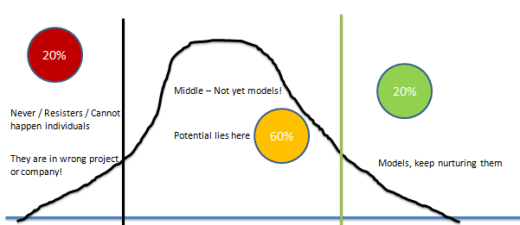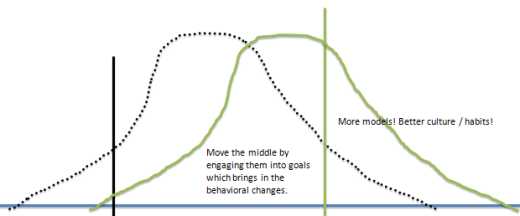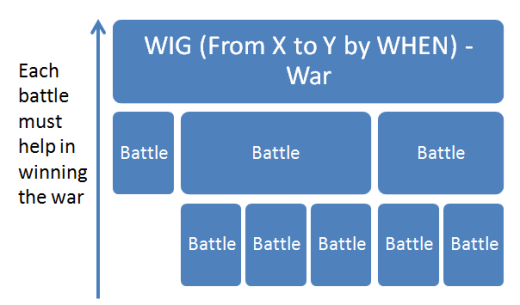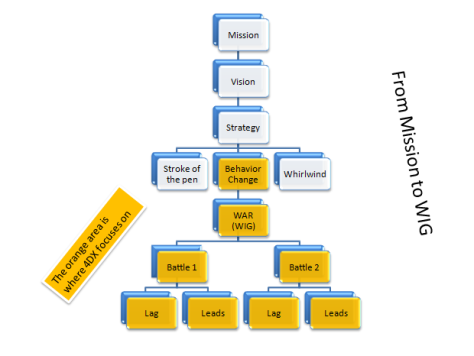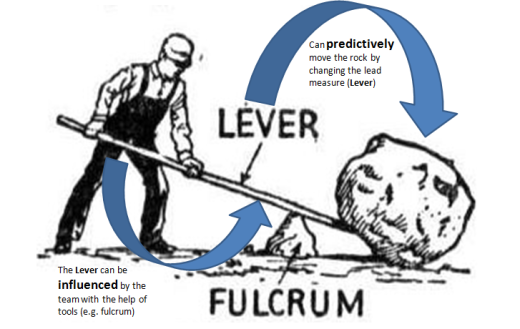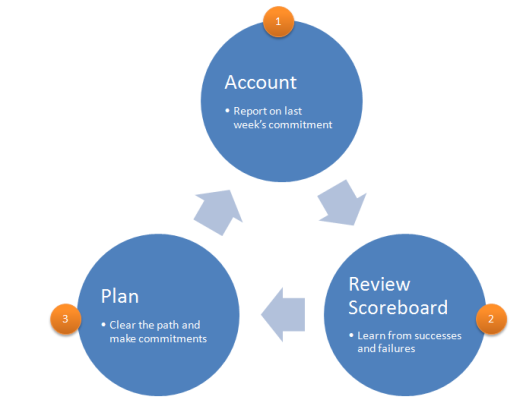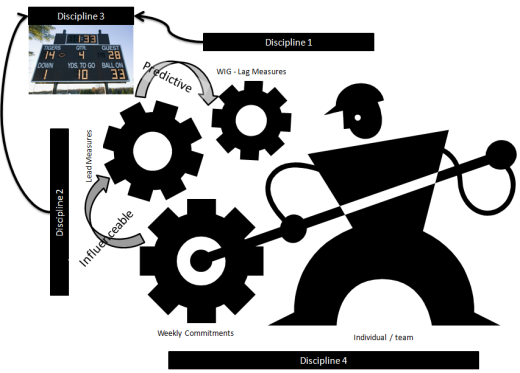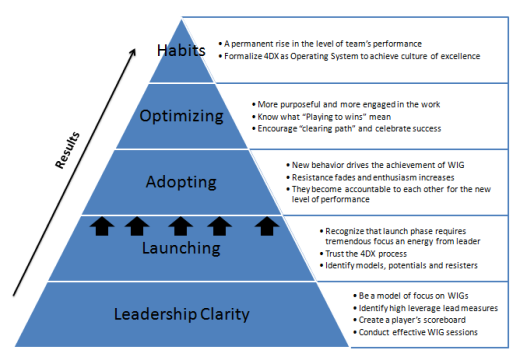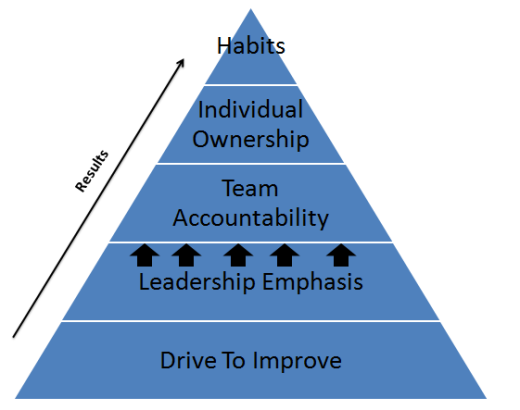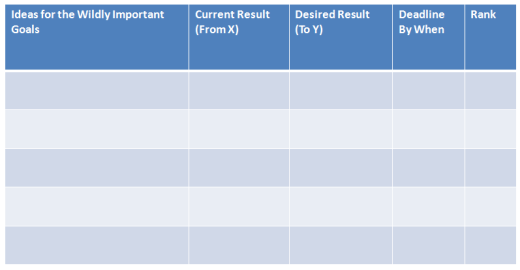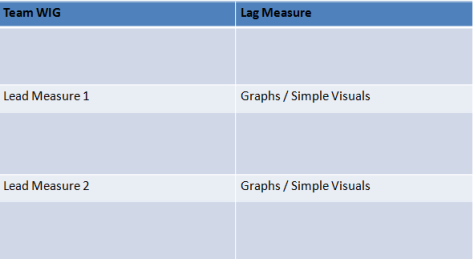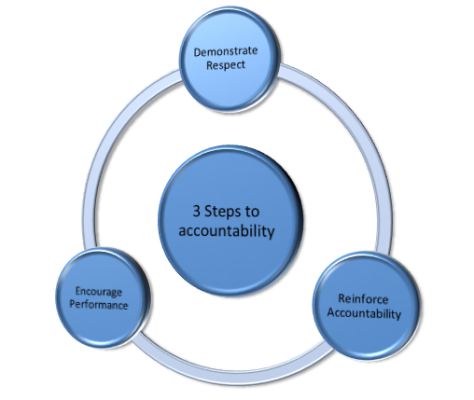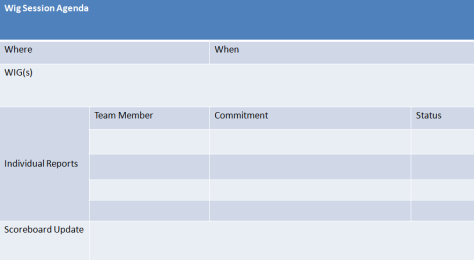Introduction
While I have always been a big fan of Steven Covey, it was amazingly great to meet with the lead author of the book, The 4 Discipline of Execution, Chris McChesney in Calgary.
While Steven Covey helps you to understand yourself and build / sharpen great habits, this book goes further ahead and talks about bringing the behavioural changes among you team members.
While covering the details of the book in this blog will be injustice, I would like to jot down few notes, which will help you to remember the concepts easily and hopefully that helps you in implementing the 4DX in your work / life in some way.
I will request you to view following video before proceeding further:
http://www.4dxbook.com/#/videos/executive_overview/
Facts & Definitions
Some of the facts that are stated or that can be inferred after reading this book are following:
- Most of the schools teach you to define strategy and they hardly teach you on execution
- Most of the time people fail on execution and the obvious reason is that you have not learned that yet
- Three reasons individuals disengage from work are – anonymity (feels their leader don’t know / care what they are doing), irrelevance (don’t understand how his / her work is creating difference) and immeasurement (unable to access their contribution)
- Whirlwind are your day-to-day job and you do need to continue with that. You cannot get rid of that as it is necessary for your survival
- Whirlwind creates urgency and it acts on you
- Goals are something important and you act on them to often smoothen the whirlwind
- Urgency and Importance don’t get along nicely and when they fight, urgency wins most of the time
- There are three types of strategy that you often see – stroke of the pen, whirlwind, behavioural changes. Bringing in behavioural change is the most difficult aspect
- Every company has 3-types of people
- Models (top performers) – generally 20%
- Middle Group – generally 60%
- Resisters – generally 20%
- As part of behavioural goal you need to move the middle and shift them towards right (model) to keep the right as tight. Of course you to need to nurture your models.
- The lesser the goals the higher the possibility of achieving them with excellence. When the number of goals are 2-3 then you can achieve 2-3 goals with excellence. Law of diminishing return is pretty much applicable on number of goals that you choose.
- We often fixate on the lag measure, which is easy to measure and easily visible success criteria and of course that is what we want to achieve. However, since we measure it after the time has been spent, we cannot do much about it.
- Lead measures lead to lag measure and it foretells whether you will achieve your lag measure or not.
- It has two important characteristics – predictive (i.e. if you do something with this then lag measure will be affected) and influenceable (it can be influenced by team).
- It eliminates elements of surprises
- People play differently when they are keeping score
Following image shows a sample distribution of different groups of people:
The 4 Discipline
Keeping facts in perspective, it is not at all easy to do following
- Identify 2-3 wildly important goals out of the whirlwind of day-to-day job or from outside
- Even if you identify them, measuring the progress becomes challenging
- Assume that you are able to measure the progress, sustaining the progress become further challenging
- Of course we desire to inculcate a great habit into the individual and team through that goal and this of course start looking like an uphill task
Following image shows the uphill task of moving the middle right and keeping the right really tight:
This is why Chris and his team has given us 4 discipline, which when strictly followed, will enable us to achieve extraordinary result. Namely, they are
- Focus on the Wildly Important Goal (WIG)
- Act on the Lead Measure
- Keep a Compelling Scoreboard
- Create a Cadence of Accountability
These 4 discipline of execution are meant for helping you to execute your important goals in the midst of the whirlwind.
WIGs
Following rules related to WIGs must be respected:
- No team should have more than 1-2 goals at any given time
- Each WIG must have a finish line – From X to Y by WHEN
- Sub-WIGs can be different but they must ensure success of the parent WIG. The battle must win the war. In other words, if a battle is not helping you to win the war then see if you can avoid that battle.
- Senior leaders can veto (on the WIGs determined by team or junior leaders) but they cannot dictate
Idea is simple, without loosing the track of the events / items in the whirlwind, bring your intense focus and put most of your energy on one (or maximum two) MOST important goal and achieve excellence in that. You do need to know that “there will always be more good ideas than there is a capacity to execute“.
In an organizational environment, the mission and vision often drives the need for behavioural change. In such cases you may like to look at the following diagram, which emphasizes the focus area of the 4DX:
Acting on lead measures
The lead measure must be
- Predictive : Measure something which leads to the WIG or Sub-WIG. What it means is that – if the lead measure change, you can predict the possible change in lag measure as well
- Influenceable : Something which can be influenced by the team. What it means is that – team or individual within the team can come up with action items which may change the lead measure
Following image shows a beautiful example of a lead measure in action:
It is often difficult to identify the lever (lead measure), which will move the rock (lag measure). It does require quite a bit of brainstorming and commitment. However, when team does come up with such lever, they bet that they can actually move the rock by moving the lever.
There are two types of lead measure and both are equally important:
- Small Outcomes – lead measures that focus team achieving the weekly committed results using the committed method(s)
- Leveraged Behaviours – lead measures that track the specific behaviours you want the team to perform throughout the week
Keep a Compelling Scoreboard
While the 4 discipline enabled you to set up a winnable game, the great teams know at every moment whether they are winning or not. This is where compelling scoreboard, the 3rd principle, plays its role by compelling the team members to remain focussed on the wildly important goals as they would love to continue winning.
The compelling scoreboard is for the whole team (coaches / leaders may have more complicated scoreboard, but that is just meant for him / her), which must have few simple information / graph on it which clearly indicates “Here’s where we need to be and here’s where we are right now“. In five seconds or less time anyone can determine whether we are winning or not.
Following is the characteristics of a compelling scoreboard:
- It has to be simple
- It has to be easily visible to the team
- It should show both – the real lead (what the team can affect) and the lag (result they want) measures
- It has to tell you immediately (five second rule) if you are winning or losing
Create a Cadence of Accountability
The 4th discipline is about creating a frequently recurring cycle (weekly)of accountability to self (individual) through commitment to the peers (team) on the ideas (lead measure) brought forward by the individual to move / change the lag measure. This is where real execution takes place. Of course a leader can judge the idea and seek better idea, however, the idea does come from the individual who are going to execute the lead measure.
This brings in truly repeated accountability due to following reason
- The idea is owned by the individual
- In the weekly WIG session the individual does commit this to the group and hold each other accountable for taking actions that will move the lead measures resulting in the achievement of the WIG despite all the whirlwind around the individual / team
- Everyone wants to win in the team
- The score is maintained at team level and thus the team (and generally team leaders) assist in choosing the effective lead measure and clears path if any blockage is being foreseen. In nutshell, individual understands that they succeed as a team or fail as a team.
- Since they bring-in the lead measure (on weekly basis, based on latest information and fresh energy) and they are keeping score, they are always in the game, which is designed to be a winnable game
WIG Session
Key to the successful implementation of 4th discipline is the sacred weekly WIG session, whose 3-part agenda is following image:
Each person gets 2-3 minutes to talk about these 3-parts where he / she updates on the previous commitment, reviews scoreboard and talks about the future plan.
The WIG session rules :
- It must be held on same day and same time without any fail otherwise the momentum will be lost and WIG will fail
- The whirlwind shall never be allowed in this session
- It must not last more than 20-30 minutes (i.e. you run this in fast and forward mode)
- Scoreboard must be updated before the WIG session
- It must be very focused on the WIG
Key Question for committing to the group is “What are the 1-2 most important things I can do this week to impact the scoreboard?“.
With all the four rules combined, this is how the system looks like:
What to expect from 4DX
Below image shows 5 stages of installing 4DX in your team:
At different stage there are different challenges and expectations. Following image shows a sample pyramid for achieving behavioural changes:
In nutshell, there is a method to install 4DX as Operating System in which you can execute WIGs to achieve the change in behaviour of the individuals / teams.
4DX templates
Focus on WIGs
Using the discovery questions like listed below, you shall be able to figure out the list of WIGs for the team which will have the overall impact on the organizational WIG
- Which one area of our team’s performance would we want to improve most
- What are the greatest strengths of the team that can be leveraged
- What are the areas where the team’s poor performance needs to be improved
Once a WIG is determined and ranked, following questions help in testing the WIGs
- Is the team WIG aligned to overall WIG
- Is it measurable?
- Who owns the result – the team must own at least 80% of the results
- Who owns the game – team or leader? Note that the game must be owned by the team.
Once the WIG passes the test, you need to define it using following criteria
- Begin with verb
- From X to Y by WHEN
- Keep it simple
- Focus on what, not how
- Must be achievable (winnable)
Once you are able to define them very clearly, choose top 2-3 WIGs on which the team shall be focussing.
Following image shows the recommended template for recording and finalizing WIGs
Act on lead measures
Like you did for coming up with WIGs, for lead measures also you need to do following
- Identify possible lead measures by asking questions like below (with respect to WIGs)
- What could we do that we have never done before?
- What strength of this team can we use as leverage on the WIGs?
- What do our best performers do differently?
- What weakness might keep us from achieving the WIG?
- What could we do more consistently?
- Rank the lead measures by its impact in WIG
- Test top lead measures using following questions
- Is it predictive?
- Is it influenceable?
- Is it an ongoing process or “once and done”?
- Is it a leader’s game or a team game?
- Can it be measured?
- Is it worth measuring?
- Does it start with verb?
- The lead measures which passes the test, define them in the final form by considering following questions
- Are we tracking team performance or individual performance?
- Are we tracking the lead measures on daily basis or weekly basis?
- What is the quantitative standard?
- What is the qualitative standard?
- Is it simple?
Following is the template for coming up with the lead measures:
Keep a compelling scoreboard
The purpose of player’s compelling scoreboard is to motivate the players to WIN through energetic actions. Also, their scoreboard has to be much simpler than the scoreboard of the coach. Also, note that the team shall be able to keep their own score and preferably design their own personalized scoreboard. Following points must be noted while coming up with the compelling scoreboard:
- Choose a theme based on the type of lead measures – e.g. trend lines, speedometer, bar chart, Andon, etc
- Put Lag as well as lead measure in a very simple way so that team can see at any point if they are winning or loosing
- Build the scoreboard
- Keep it updated on agreed frequency through the responsible person(s)
Following is a sample template for creating a scoreboard:
Create a cadence of accountability
The cadence of accountability starts with the question “What are the one or two most important things I can do this week to impact the team’s performance on the scoreboard?”
In above question you may like to note following qualities
- Very specific and focussed commitment with specific outcomes
- Well defined personal responsibility without any condition (with respect to day-to-day job)
- Time bound – zero tolerance for unfulfilled commitments
- Aligned to moving the scoreboard
Following diagram shows the 3-steps to accountability with all the due respect to the whirlwind:
Key to this 3-step accountability is a successful WIG session. Following important aspects must be respected for a successful WIG session
- Hold WIG session as scheduled – every week same day, same time and at same place
- Keep the session brief – 20-30 minutes
- Set the standard as a leader – you shall not be asking your team anything which you are unwilling to do yourself
- Post the scoreboard – Update the scoreboard before the session
- Celebrate successes – reinforce commitment to WIG by congratulating team and the individual
- Share learning
- Refuse to let whirlwind enter
- Clear the path for each other
- Execute in spite of the whirlwind
Below is the sample template for managing WIG Session:
While you can come up with your own template, the bottom line is that there should be a way to ensure participation and fulfilment of commitments.
Rolling Out 4DX
Following are the key aspects of successful roll out of the 4 disciplines
- must be implemented as a process, not an event
- must be implemented with intact teams
- must be implemented by the leaders closest from the front line
Following 6 step installation process leads to adoption of 4 discipline as an Operating System:
- Clarify the overall WIG
- Design the team WIGs and Lead Measures
- Leader clarification – Scoreboard design, WIG Session Skill and Launch meeting preparation
- Team Launch
- Execution with coaching
- Quarterly summits
Great Quotes
I really liked following quotes in this book:
- If luck is playing significant role in your career, then you are fixating on lag measure!
- There will always be more good ideas than there is a capacity to execute
- Many believe that engagement drive results, however, we know now, and have witnessed over the years, that results drive engagement
- Nothing affects morale and engagement more powerfully than when a person feels he or she is winning
- People are not stupid and they are not lazy; they are just busy
- If all you have is a hammer, everything looks like a nail
- The pain of discipline is far less than the pain of regret
References
- http://businessexcellenceclub.com/change/effective-execution
- https://charger4dx.wikispaces.com/Chapter+2+Lag+and+Lead+Measures
- https://www.my4dx.com/library/videos/NewLook/index.html
- http://www.4dxbook.com/
- https://www.team.my4dx.com/
- http://addicted2success.com/motivation/23-rare-motivational-quotes-that-will-knock-your-block-off/
- http://www.youtube.com/watch?v=vQnOMY98fGg
- http://www.fastcompany.com/1835210/how-set-wildly-important-goals-and-what-theyll-do-you
- https://classes.lt.unt.edu/Summer_10W_2012/CECS_5420_020/lah0228/final-project/educational-projects/powerpoint/WIG_Powerpoint.pdf

